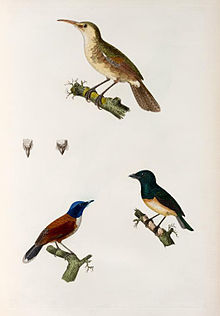Nightingale reed warbler
| Nightingale reed warbler | |
|---|---|

| |
| Nightingale Reed-warbler | |
| Scientific classification | |
| Domain: | Eukaryota |
| Kingdom: | Animalia |
| Phylum: | Chordata |
| Class: | Aves |
| Order: | Passeriformes |
| Family: | Acrocephalidae |
| Genus: | Acrocephalus |
| Species: | †A. luscinius
|
| Binomial name | |
| †Acrocephalus luscinius | |
| Synonyms | |
| |
The nightingale reed warbler (Acrocephalus luscinius), or Guam reed warbler, is a song bird endemic to the Mariana Islands. It has not been reported since the late 1960s on Guam and is now considered extirpated from that island, though the bird can still be found on the nearby island of Saipan.
Taxonomy and systematics
The nightingale reed warbler was described by the French zoologists Jean Quoy and Joseph Gaimard in 1832 from a specimen collected on the island of Guam in the western Pacific Ocean. They coined the binomial name, Thryothorus luscinius.[2][a] Until 2011, the Pagan reed warbler, Aguiguan reed warbler, and Saipan reed warbler were considered as subspecies of the nightingale reed warbler until split by the IOC.[4]
Threats
The nightingale reed warbler was driven to extinction by several introduced species. These included the brown tree snake which has also decimated the populations of several other bird species on Guam. Other introduced predators included rats, cats and feral ungulates such as goats or sheep.[5] An introduced plant, ivy gourd, destroyed the canopy of the trees nightingale reed warblers built their nests in. Wetland destruction, fires and pesticides, as well as intensive land use for agriculture or building further reduced the available habitat.[6]
Notes
References
- ^ BirdLife International (2013). "Acrocephalus luscinius". IUCN Red List of Threatened Species. 2013. Retrieved 26 November 2013.
{{cite journal}}: Invalid|ref=harv(help) - ^ Quoy, Jean; Gaimard, Joseph Paul (1830). Dumont d'Urville, Jules (ed.). Voyage de la corvette l'Astrolabe : exécuté par ordre du roi, pendant les années 1826-1827-1828-1829: Zoologie (in French). Vol. Volume 1. Paris: J. Tastu. pp. 202–203.
{{cite book}}:|volume=has extra text (help) - ^ Mlíkovský, Jiří (2012). "The dating of the ornithological part of Quoy and Gaimard's "Voyage de l'Astrolabe"". Zoological Bibliography. 2 (2&3): 59–69.
- ^ "Species Version 2 « IOC World Bird List". www.worldbirdnames.org. Retrieved 2018-06-13.
- ^ Rounds, Rachel; Radley, Paul. "Nightingale Reed-Warbler (Acrocephalus luscinia)". Web Page of Pacific Bird Conservation, Hawaii. Archived from the original on 21 September 2015. Retrieved 21 September 2015.
- ^ "Acrocephalus luscinius". IUCN Red List of Threatened Species. 2013. 2013. doi:10.2305/IUCN.UK.2013-2.RLTS.T22714770A48028066.en.

